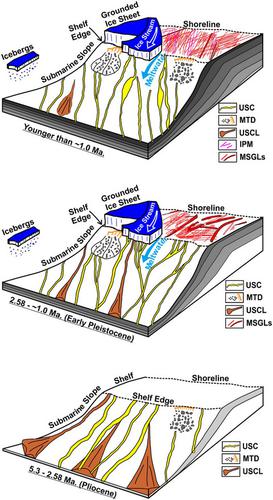当前位置:
X-MOL 学术
›
Basin Res.
›
论文详情
Our official English website, www.x-mol.net, welcomes your
feedback! (Note: you will need to create a separate account there.)
Pliocene–Pleistocene glacimarine shelf to slope processes in the south‐western Barents Sea
Basin Research ( IF 2.8 ) Pub Date : 2020-09-27 , DOI: 10.1111/bre.12516 Dicky Harishidayat 1 , Ståle Emil Johansen 1 , Christine Batchelor 1 , Kamaldeen Olakunle Omosanya 1, 2 , Ludovico Ottaviani 3, 4
Basin Research ( IF 2.8 ) Pub Date : 2020-09-27 , DOI: 10.1111/bre.12516 Dicky Harishidayat 1 , Ståle Emil Johansen 1 , Christine Batchelor 1 , Kamaldeen Olakunle Omosanya 1, 2 , Ludovico Ottaviani 3, 4
Affiliation

|
The glacimarine shelf‐edge is a complex depositional environment in which the interplay between accommodation and glaciation has played an important role in influencing sediment deposition and margin architecture. It can be challenging to unravel the history of basin infill in these areas, particularly where landforms are deeply buried. This study presents an integrated workflow for deciphering the architecture and evolution of erosional and depositional elements in a crucial location of the south‐western Barents Sea margin, with a focus on the comparatively poorly understood processes and patterns of glacimarine sedimentation that occurred during the Pliocene and Early Pleistocene. Wellbore interpretations of lithology are combined with the analysis of seismic facies, geomorphology and attributes using merged 3D seismic reflection data to investigate the morphology and development of buried landforms and depositional features on the outer‐shelf, shelf edge and upper‐slope. The Pliocene (preglacial) slope system is dominated by upper‐slope channels, upper‐slope channels with associated sediment lobes, and mass‐transport deposits. The first appearance of mega‐scale glacial lineations in the study area is close to the onset of the Pleistocene (around 2.58 Ma), suggesting that an ice stream reached the palaeo‐shelf edge during the earliest Pleistocene. The prevalence of upper‐slope channels and mass‐transport deposits throughout the Pleistocene stratigraphy shows that the basinwards transfer of sediment took place mainly by evacuation of sediment through relatively linear channels combined with mass‐movement events. The results presented in this study have implications for understanding the glacial history of the south‐western Barents Sea and sedimentary processes on glacimarine shelf edges more generally.
中文翻译:

在巴伦支海西南部的上新世—更新世冰川期陆架
冰川湖架边缘是一个复杂的沉积环境,其中调节作用和冰川作用之间的相互作用在影响沉积物沉积和边缘构造方面起着重要作用。在这些地区,尤其是在地貌被深埋的地区,要揭示盆地填充的历史可能具有挑战性。这项研究提出了一个综合的工作流程,用于解释西南巴伦支海边缘关键位置的侵蚀和沉积元素的结构和演化,重点是在上新世和新世纪期间发生的相对较不了解的冰川沉积过程和模式。早更新世。井眼对岩性的解释与地震相的分析相结合,使用合并的3D地震反射数据对地貌和属性进行研究,以研究地幔,架子边缘和上坡的地貌形态和发育以及沉积特征。上新世(冰川前)斜坡系统主要由上斜坡通道,具有相关沉积物波瓣的上斜坡通道和大量输运沉积物主导。研究区的大型冰川系的首次出现接近更新世的开始(约2.58 Ma),这表明冰河流在最早的更新世期间就到达了古陆架边缘。在整个更新世地层中,上坡通道和大量输运沉积物的普遍存在表明,沉积物向盆地的转移主要是通过相对线性的通道将沉积物疏散并结合质量运移事件而发生的。这项研究提出的结果对理解西南巴伦支海的冰川历史和更普遍的冰川湖大陆架边缘的沉积过程具有启示意义。
更新日期:2020-09-27
中文翻译:

在巴伦支海西南部的上新世—更新世冰川期陆架
冰川湖架边缘是一个复杂的沉积环境,其中调节作用和冰川作用之间的相互作用在影响沉积物沉积和边缘构造方面起着重要作用。在这些地区,尤其是在地貌被深埋的地区,要揭示盆地填充的历史可能具有挑战性。这项研究提出了一个综合的工作流程,用于解释西南巴伦支海边缘关键位置的侵蚀和沉积元素的结构和演化,重点是在上新世和新世纪期间发生的相对较不了解的冰川沉积过程和模式。早更新世。井眼对岩性的解释与地震相的分析相结合,使用合并的3D地震反射数据对地貌和属性进行研究,以研究地幔,架子边缘和上坡的地貌形态和发育以及沉积特征。上新世(冰川前)斜坡系统主要由上斜坡通道,具有相关沉积物波瓣的上斜坡通道和大量输运沉积物主导。研究区的大型冰川系的首次出现接近更新世的开始(约2.58 Ma),这表明冰河流在最早的更新世期间就到达了古陆架边缘。在整个更新世地层中,上坡通道和大量输运沉积物的普遍存在表明,沉积物向盆地的转移主要是通过相对线性的通道将沉积物疏散并结合质量运移事件而发生的。这项研究提出的结果对理解西南巴伦支海的冰川历史和更普遍的冰川湖大陆架边缘的沉积过程具有启示意义。











































 京公网安备 11010802027423号
京公网安备 11010802027423号